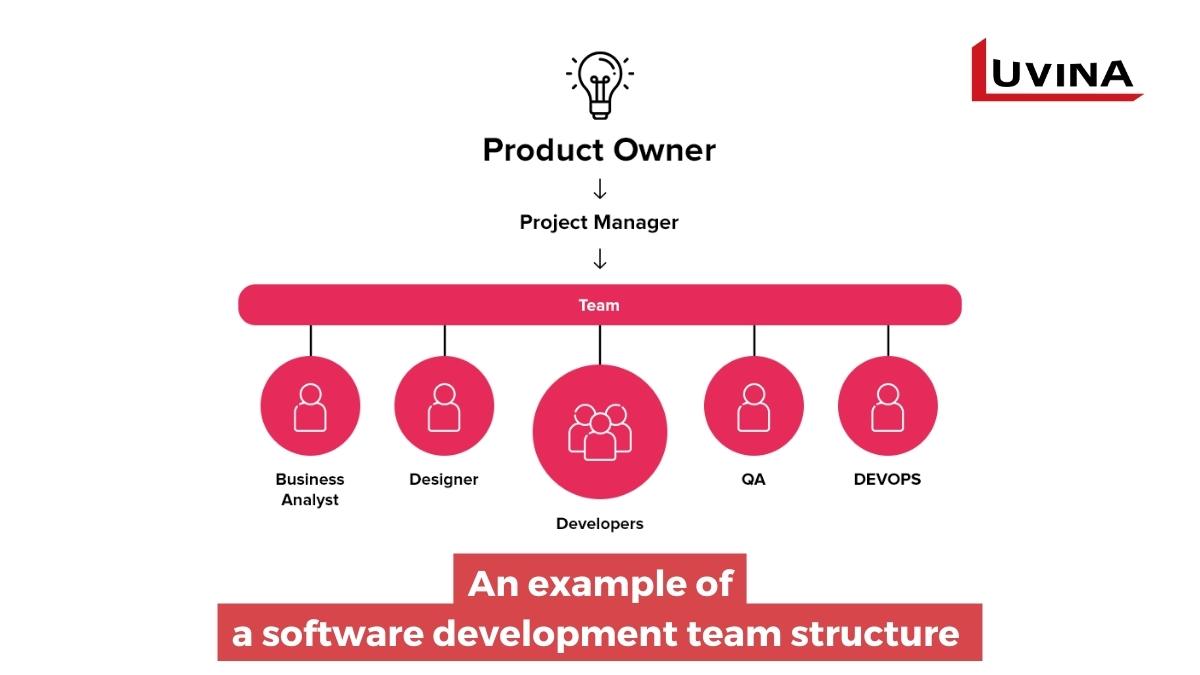Determining the ideal team size for a custom software development outsourcing project not only helps optimize costs but also improves project performance. And of course, you cannot simply pick a random number of team members for the team. So, how can you determine the team size? The answer is in the article below.
A recent study by ResearchGate has revealed that there are 3 key factors influencing the effectiveness of software development: the platform, programming language, and team size. Among these, having an appropriate team size is considered the most critical factor.
You cannot complete any IT project without a team. However, having a larger team doesn’t necessarily translate to higher efficiency. In software development, quality is more important than quantity. If the team is too large, it may impact individual and overall productivity.
So, how can you determine the optimal team size for your custom software development outsourcing project?

In response to the rapidly evolving market demands, a great number of businesses have a penchant for implementing superior and cutting-edge digital solutions developed exclusively for the current state of their business, such as custom software development. Beyond immediate immediate efficiency gains, these bespoke softwares could even offer significant long-lasting advantages such as reduced operational risks, lower overall costs, or increased scalability.
Nonetheless, we have noticed that many people, especially newcomers in the market, might now still be in the dark about the definitions, types of customized software, and ways to find the right development team size. Therefore, in this article, we will help you answer these essential questions:
- “What is custom software development?”
- “What are types of customized software?”
- “How to choose the suitable team size for your CSD projects?”
What is Custom Software Development?
Simply put, custom software development, or bespoke software development, refers to the software applications that are designed and specifically tailored to meet the exclusive needs and requirements or to address existing problems within an organization or user.
Custom software development comprises various processes ranging from designing, developing, deploying, assessing, and maintaining software. These tasks can be handed out to either an in-house team or an external specialized provider, depending on the company’s unique needs.
Different from custom off-the-shelf software solutions (COTS), such as Microsoft Office, created to meet the needs of a wide range of customers at an affordable price, custom Software Development is a highly personalized digital solution, aiming at resolving unique problems or aligning with the certain conditions of the company.
The main benefits of Custom software development approach lie in its abilities to enhance flexibility of the company’s operational procedures, facilitate adaptability, scalability, agility, and put a restraint on additional costs.
Types of Customized Software
For every software solution currently available within the business landscape, a custom software development approach can consistently offer a similar yet superior, tailored alternative. Let’s take a look at the diverse array of personalized software solutions that the majority of outsource software companies provide in this day and age:
Content Management System (CMS)
Customer Management System is the type of software that provides space, platform, and resources to build the content of a website or even the whole website from scratch. CMS also helps to maintain the website and perhaps suggests ways to take the website to the next level.
Some common examples of Content Management Systems include WordPress, Joomla, and Drupal, Heartcore to name but a few. Each of these commercial off-the-shelf software will be applied in distinct companies to fulfill different needs.
The greatest advantage of CMS is that it does not require you to use coding languages to create and manage a company’s websites. Moreover, with CMS, you can store, restore, control, add, edit, or format content with more ease, even after publishing.
A standard customized CMS software will not only assist you to derive the existing pros of COTS CMS software but also bring about numerous benefits related to its capability to scale up, flexibly adjust, or save maintenance time as well as efforts.
Customer Relationship Management (CRM)
A burgeoning number of customers has come hand in hand with the fast-paced development of the business market. This has resulted in the urgent need for a specific system to manage customer data and help businesses take advantage of this big data to leverage relationships and their products or services’s appeals to enormous numbers of potential customers. That’s Customer Relationship Management (CRM).
CRM software is now applied in the majority of businesses, especially in companies focusing on providing superior service quality. With the help of CRM, businesses can manage their previous, current customers, and contacts on a diversity of social media platforms, or even detect and provide a list of prospects.
Some of the currently available CRM software are Hubspot, Zendesks, Salesforce, or Microsoft Dynamics, etc.
>> Also read: CRM Development: Unlocking Growth in the Digital Era
Enterprise Resource Planning (ERP)
ERP software is widely utilized by companies wanting to streamline and manage their operational procurement, projects, accounting activities, risk detection, or optimize supply chain efficiency.
Nowadays, a great number of ERP systems also offer a comprehensive platform for managers to keep track of project performance, paving the way for more compatible strategic plans, budget management, and forecasts of revenue. All in all, ERP software can be deemed the best solution to simplify business projects and smoothwn workflows.
SAP Business One, Tally Prime, Microsoft Dynamics 365 Business Central, NetSuite, Workday ERP, etc. are some examples of popular ERP software.
>> Also read: ERP Development Full Guide: All You Need To Know
Human Resource Management System (HRMS)
Human Resource Management Systems (HRMS) or Human Resources Information System (HRIS) is a cutting-edge type of software designed to ensure the effective management of human resources.
A typical MRM module will be utilized to help store, and organize relevant candidate or personnel information, guarantee timely and precise payroll, enhance retention and engagement rates, as well as track staff performances within the whole organization.
With HRMS software, better decisions correlated with the workforce would be improved significantly. Some off-the-shelf software solutions that you might have encountered from time to time: Workday Solution, BambooHR, SAP SuccessFactors, Oracle HCM Cloud, ADP Workforce Now, etc.
Enterprise Asset Management (EAM)
Implementing an EAM software solution is regarded as one of the most potent tools to manage, track, and control organizational physical assets throughout their lifecycle. By providing a centralized platform, EAM software helps businesses to put their asset utilization, cost reduction, and downtime minimization to maximum, facilitating superior effectiveness in business procedures.
A comprehensive and qualified software will enable your businesses to gain precious insights into asset performance, identify maintenance needs, and make data-driven decisions to improve asset management practices.
Speaking of popular EAM software, there are some cloud-based EAM software such as IBM Maximo Application Suite, Infor EAM, Oracle EAM, or manifold on-premise EAM software naming AssetWise, Hitachi EAM, or GE Digital Asset Management, etc.
E-commerce Platforms
The exponential growth of e-commerce following the COVID-19 pandemic has highlighted the pressing necessity for a robust and efficient management of online tools. As online retailers grapple with increased sophistication, a diverse ecosystem of e-commerce platforms has emerged, including COTS options such as Magento, Shopify, Adobe Commerce, Wix, WooCommerce, BigCommerce, and more.
Even with the increasing number of companies specializing in custom software development services, businesses now have a plethora of choices to cater to their specific needs.
3 Important Factors to Consider
1. Project scope and complexity
The first factor you need to consider is the scope and complexity of the project. By determining these aspects, you can outline the necessary tasks, required resources, and the number of specialists needed for the project.
The bigger the project, the larger the team you need. In some cases, you may need to hire multiple specialists to handle different separate roles. However, the necessity of this depends on the project’s complexity.
For example, a Software Development project (or a customized package) will require a larger team with more specialists than a Software Testing or Maintenance project. Additionally, the complexity of the project is influenced by the industry and type of software involved.
2. Budget and timeline
The next important factors to consider when determining the team size for a custom software development outsourcing project are the timeline and budget.

Be EXACT about the time and budget you can allocate for your software project. Avoid setting vague goals like “faster and cheaper the better.” Having an unclear budget may lead you to fall into the trap of “cutting workforce to save money,” resulting in project delays.
On the other hand, knowing the precise time you want to release the product and the exact budget you can invest in will help IT outsourcing companies advise on the appropriate team size for the project.
3. Available resources and skills
What tools do you need to complete the project? Do you already have any tools in place? What skills does your team require? Do you have any team members with those skills yet?
These are all important questions you must answer when building a team for a custom software development outsourcing project.
When determining the size of the software development team, you need to ensure that the skill gap between team members is not too large. Specifically, each member should have their strengths and roles, avoiding stacking individuals with the same shared skills in one team to prevent affecting the productivity of each individual.
Ideal Software Development Team Size and Roles
You won’t be able to find an exact answer to the question “How many members are needed for a custom software development outsourcing project?”. Larger projects often require a larger team, but sometimes smaller teams, which are easier to manage, can be highly valued in software development.
So, is there a way to determine the ideal team size for your project?
1. The formula for determining the ideal team size
Speaking about team size, in an interview, Amazon’s CEO Jeff Bezos once shared a humorous observation that if you buy two pizzas for a team and there’s not enough to go around, it means the team is too large to work efficiently.

Of course, this is just a lighthearted way of talking about the size of a working team. However, Bezos’s statement holds some truth in a certain aspect. Because in software development, having a large team doesn’t necessarily guarantee efficient work.
When establishing a development team, it is essential to consider the team’s needs rather than just random numbers. Here are some factors to consider:
- Expertise: Each team member should have specialized skills that align with the project’s goals. For each skill set, there should be an expert and a person with basic knowledge to support each other.
- Stability: Team members should focus on one project and have the ability to commit long-term, as the technology industry requires regular maintenance and updates.
- Diverse Experience: Rich experiences serve as a foundation for new ideas and foster more flexible and diverse approaches to work.
- Openness and Willingness to Learn: Project participants should be open to learning new technological knowledge, such as new programming languages and technologies, and even outside the technology domain. Understanding other industries is crucial for developing technology products for those fields.
Increasing team size and interactions can affect productivity. Therefore, this formula serves as an important communication load calculation to help you identify the appropriate team size.
2. Roles included in the team
When determining the team size for a custom software development outsourcing project, you need to have a clear understanding of what the project requires to outline the distinct roles and tasks of each team member. Every software development team needs a combination of roles, and here are some specific roles:
- Project Manager: Manages the team, monitors project progress, and ensures the set objectives are achieved.
- Business Analyst (BA): Build goals, document, and evaluate core processes and systems, ensuring technology aligns with the business model. BA proposes development directions for the business after assessing what is effective and what is not.
- Backend Developers: Write web services and APIs, and manage server-side logic.
- Frontend Developers: Implement software designs, responsible for user experience and interactions.
- UI/UX Designers: Create visually appealing designs, icons, backgrounds, themes, and banners to make the product engaging and user-friendly.
QA (Quality Assurance) or Tester: Conduct final testing to ensure the software is ready to use.

Custom Software Development Outsourcing Solution
Low cost and time saving are just two of many reasons why businesses nowadays prefer using IT outsourcing rather than building an in-house team. So, what benefits can IT outsourcing bring that businesses are so fond of?
1. Benefits of IT outsourcing
Cost savings
When deciding to hire IT outsourcing, you won’t have to worry about additional costs such as recruitment, training, equipment, storage, etc. After completing the project, you also don’t need to be concerned about the idle costs of personnel and invested machinery. This is why this approach is much more cost-effective compared to operating an in-house IT team.
Improving work efficiency, optimizing processes
IT systems often have operational errors that can impact the productivity and progress of a business. IT outsourcing companies are experts in their field. Therefore, they are adept at quickly identifying and resolving issues for businesses while investing significantly in tools and solutions to enhance service quality for their clients.

Having a professional team
The larger the projects, the more they require a specialized and professional team as professional teams can commit to project results and speed. Outsourcing IT is a way to quickly own a team of experts without the hassle of searching for individuals or managing a team as in building an in-house IT team.
2. The basic models of IT outsourcing companies
Currently, there are various models for IT outsourcing, but below are the 2 most common ones:
Project-based model
In this model, you will assign the entire project’s responsibility to a third-party provider. Beforehand, you need to provide complete project requirements to the IT outsourcing company’s team members. Subsequently, these outsourcing companies will form their team and oversee the project until completion.
Team-based model
The team-based model allows you to hire developers to work for you remotely on a full-time basis and report directly to you while remaining within a dedicated team. These developers can either build a development team for you or collaborate with your in-house developers.

With nearly 20 years of experience in software development and IT outsourcing solutions, Luvina can assist you in consulting and building a team that fits your company’s project.
Since 2004, Luvina has been providing services and development support to numerous businesses across various industries. Luvina understands the needs and expectations of businesses when using IT outsourcing services, thereby advising the most optimal solutions to help businesses achieve their goals.
Final Thoughts
You certainly cannot determine the team size for a custom software development outsourcing project by randomly choosing several team members. Instead, you need to carefully analyze all factors, from budget to project complexity, timeline, and more.
The most important lesson you should learn from this article is that when building a software development team, quality is more important than quantity. If you don’t want to spend too much time researching how to build an IT team and prefer to focus on developing the core values of your organization, then hiring IT outsourcing is the optimal solution.









Read More From Us?
Sign up for our newsletter
Read More From Us?
Sign up for our newsletter